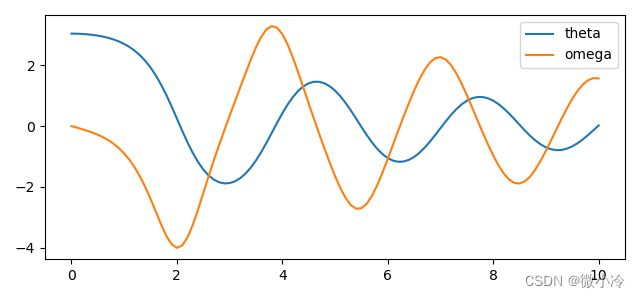如何用Python求解微分方程组
文章目录
-
- odeint简介
- 示例
odeint简介
scipy文档中将odeint函数和ode, comples_ode这两个类称为旧API,是scipy早期使用的微分方程求解器,但由于是Fortran实现的,尽管使用起来并不方便,但速度没得说,所以有的时候还挺推荐使用的。
其中,odeint的参数如下
scipy.integrate.odeint(func, y0, t, args=(), Dfun=None, col_deriv=0, full_output=0, ml=None, mu=None, rtol=None, atol=None, tcrit=None, h0=0.0, hmax=0.0, hmin=0.0, ixpr=0, mxstep=0, mxhnil=0, mxordn=12, mxords=5, printmessg=0, tfirst=False)
其中func为待求解函数;y0为初值;t为自变量列表,其他参数都有默认选项,可以不填,而且这些参数非常多,其中常用的有
argsfunc中除了t之外的其他变量Dfunfunc的梯度函数,当此参数不为None时,若将col_deriv设为True,则可提升效率。full_output如果为True,则额外返回一个参数字典ml=None, mu=None, rtol=None, atol=None, tcrit=None, h0=0.0, hmax=0.0, hmin=0.0, ixpr=0, mxstep=0, mxhnil=0, mxordn=12, mxords=5,printmessg为True时打印信息。tfirst当为False时,func的格式为func(y,t...),否则格式为func(t, y...)
示例
对于常微分方程
θ ′ ′ ( t ) + b θ ′ ( t ) + c sin θ ( t ) = 0 b = 0.25 ; c = 5 θ ( 0 ) = π − 0.1 ; θ ′ ( 0 ) = 0 \theta''(t)+b\theta'(t)+c\sin\theta(t)=0\\ b=0.25;\quad c=5\\ \theta(0)=\pi-0.1;\quad \theta'(0)=0 θ′′(t)+bθ′(t)+csinθ(t)=0b=0.25;c=5θ(0)=π−0.1;θ′(0)=0
将其中的二阶导数项用一个新变量替代, ω ( t ) = θ ′ ( t ) \omega(t)=\theta'(t) ω(t)=θ′(t),则常微分方程可拆分成微分方程组
θ ′ ( t ) = ω ( t ) ω ′ ( t ) = − b ω ( t ) − c sin θ ( t ) \begin{aligned} \theta'(t)&=\omega(t)\\ \omega'(t)&=-b\omega(t)-c\sin\theta(t) \end{aligned} θ′(t)ω′(t)=ω(t)=−bω(t)−csinθ(t)
令 y = [ θ , ω ] y=[\theta, \omega] y=[θ,ω],则 y ′ = [ θ ′ , ω ′ ] y'=[\theta', \omega'] y′=[θ′,ω′],据此可设计函数func
import numpy as np
def pend(y, t, b, c):
th, om = y
dydt = [om, -b*om - c*np.sin(th)]
return dydt
然后调用并求解
from scipy.integrate import odeint
y0 = [np.pi-0.1, 0]
t = np.linspace(0, 10, 101)
sol = odeint(pend, y0, t, args=(0.25, 5))
然后绘制一下结果
import matplotlib.pyplot as plt
plt.plot(t, sol[:,0], label="theta")
plt.plot(t, sol[:,1], label="omega")
plt.legend()
plt.show()
这个形状还是比较离奇的。
